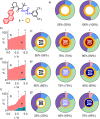Electric-Field Catalysis on Carbon Nanotubes in Electromicrofluidic Reactors: Monoterpene Cyclizations
- PMID: 39387156
- PMCID: PMC11753599
- DOI: 10.1002/anie.202417333
Electric-Field Catalysis on Carbon Nanotubes in Electromicrofluidic Reactors: Monoterpene Cyclizations
Abstract
The control over the movement of electrons during chemical reactions with oriented external electric fields (OEEFs) has been predicted to offer a general approach to catalysis. Recently, we suggested that many problems to realize electric-field catalysis in practice under scalable bulk conditions could possibly be solved on multiwalled carbon nanotubes in electromicrofluidic reactors. Here, we selected monoterpene cyclizations to assess the scope of our system in organic synthesis. We report that electric-field catalysis can function by stabilizing both anionic and cationic transition states, depending on the orientation of the applied field. Moreover, electric-field catalysis can promote reactions which are barely accessible by general Brønsted and Lewis acids and field-free anion-π and cation-π interactions, and drive chemoselectivity toward intrinsically disfavored products without the need for pyrene interfacers attached to the substrate to prolong binding to the carbon nanotubes. Finally, interfacing with chiral organocatalysts is explored and evidence against contributions from redox chemistry is provided.
Keywords: Oriented external electric fields; anion-π catalysis; carbon nanotubes; cation-π catalysis; cyclizations; flow chemistry; hydride shifts; microfluidics; terpenes.
© 2024 The Authors. Angewandte Chemie International Edition published by Wiley-VCH GmbH.
Conflict of interest statement
The authors declare no conflict of interest.
Figures




References
-
- Shaik S., Danovich D., Joy J., Wang Z., Stuyver T., J. Am. Chem. Soc. 2020, 142, 12551–12562. - PubMed
-
- Ciampi S., Darwish N., Aitken H. M., Díez-Pérez I., Coote M. L., Chem. Soc. Rev. 2018, 47, 5146–5164. - PubMed
-
- Kareem S., Vali S. R., Reddy B. V. S., Eur. J. Org. Chem. 2023, 26, e202300103.
-
- Blyth M. T., Noble B. B., Russell I. C., Coote M. L., J. Am. Chem. Soc. 2020, 142, 606–613. - PubMed
Grants and funding
LinkOut - more resources
Full Text Sources
Research Materials
Miscellaneous

